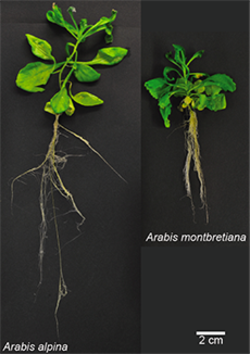Understanding the root of perennials: Analyses below the surface
An important divergence in plant life styles is whether they are determined to produce progeny one time (annual plant species) or several times (perennial plant species) in their live. While the latter evolved the ability to survive over a long time and give rise to new generations frequently, annual plant species have to ensure the existence of the next generation with one single try via the production of large amounts of seeds. Due to their faster growth and the small amount of time they need until production of fruits/seeds, most of our traditional domesticated food plants like corn (Zea mays), wheat (Triticum), rice (Oryza) and pea (Pisum sativium) are bred on the basis of annual plants, providing large yields but need to be sowed and raised all new every seasonal cycle. Thereby they consume a large quantity of nutrients, which has to be provided by the soil. In contrast to our agricultural areas, huge parts of the natural environments are dominated by perennial plants like trees (Acer, Pinus, Quercus, …), fern (Pteridophyta) and grasses (e.g. Poaceae), which are managing to survive, grow further and produce progeny over a long time and thereby residing in the same soil all their life.
Our aim within CEPLAS is the understanding of the different aspects diverging between annual and perennial life styles and thereby uncovering beneficial growth mechanisms of perennial plant species, which were lost due to domestication or never present at all in our food plants. One crucial aspect differing between both life styles is the development and maintenance of the root system. Perennial plants that survive over a longer period of time throughout seasons and years on the same spot within the same soil have evolved different growth strategies than annual plants, which aim at a high growth rate of above ground structures enabling a rapid production of progeny at the determined end of their life cycle.
These strategies evolved by perennials can be of structural nature like very deep or widely expanded root systems but can also involve systematic mechanisms like the balance of maintenance and senescence of roots during winter seasons and drought periods. Several of those strategies that have been evolved in perennial species could become advantages in future crop plants. For example deeper rooting and sustained root growth maintenance could be key aspects enabling the cultivation of crop plants in regions, which are due to erosion and difficult to access water reservoirs at the moment non-arable.
To uncover those root growth strategies and – important for the later use of that information – the underlying genetic mechanisms in perennial plants, we utilize the closely related Brassicacea species Arabis alpina (perennial) and Arabis montbretiana (annual) as a model for comparative studies. So far, our phenotypic analyses show as expected significant differences in root growth dynamics and architecture, which enables us to define perennial specific root growth mechanisms. The fact that the two model species are evolutionary very closely related and therefore harbour similar genomes, enables us in the next step to understand genetic mechanisms that are underlying the evolutionary divergence between both species in parallel to the observation of their root development.
Contribution by Helge Pallakies, Heinrich Heine University
Planter’s Punch
Under the heading Planter’s Punch we present each month one special aspect of the CEPLAS research programme. All contributions are prepared by our young researchers.
